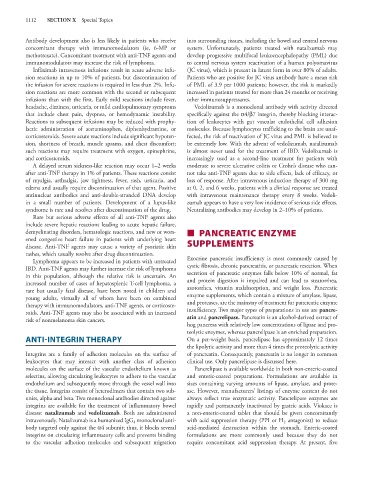Page 1126 - Basic _ Clinical Pharmacology ( PDFDrive )
P. 1126
1112 SECTION X Special Topics
Antibody development also is less likely in patients who receive into surrounding tissues, including the bowel and central nervous
concomitant therapy with immunomodulators (ie, 6-MP or system. Unfortunately, patients treated with natalizumab may
methotrexate). Concomitant treatment with anti-TNF agents and develop progressive multifocal leukoencephalopathy (PML) due
immunomodulators may increase the risk of lymphoma. to central nervous system reactivation of a human polyomavirus
Infliximab intravenous infusions result in acute adverse infu- (JC virus), which is present in latent form in over 80% of adults.
sion reactions in up to 10% of patients, but discontinuation of Patients who are positive for JC virus antibody have a mean risk
the infusion for severe reactions is required in less than 2%. Infu- of PML of 3.9 per 1000 patients; however, the risk is markedly
sion reactions are more common with the second or subsequent increased in patients treated for more than 24 months or receiving
infusions than with the first. Early mild reactions include fever, other immunosuppressants.
headache, dizziness, urticaria, or mild cardiopulmonary symptoms Vedolizumab is a monoclonal antibody with activity directed
that include chest pain, dyspnea, or hemodynamic instability. specifically against the α4/β7 integrin, thereby blocking interac-
Reactions to subsequent infusions may be reduced with prophy- tion of leukocytes with gut vascular endothelial cell adhesion
lactic administration of acetaminophen, diphenhydramine, or molecules. Because lymphocytes trafficking to the brain are unaf-
corticosteroids. Severe acute reactions include significant hypoten- fected, the risk of reactivation of JC virus and PML is believed to
sion, shortness of breath, muscle spasms, and chest discomfort; be extremely low. With the advent of vedolizumab, natalizumab
such reactions may require treatment with oxygen, epinephrine, is almost never used for the treatment of IBD. Vedolizumab is
and corticosteroids. increasingly used as a second-line treatment for patients with
A delayed serum sickness-like reaction may occur 1–2 weeks moderate to severe ulcerative colitis or Crohn’s disease who can-
after anti-TNF therapy in 1% of patients. These reactions consist not take anti-TNF agents due to side effects, lack of efficacy, or
of myalgia, arthralgia, jaw tightness, fever, rash, urticaria, and loss of response. After intravenous induction therapy of 300 mg
edema and usually require discontinuation of that agent. Positive at 0, 2, and 6 weeks, patients with a clinical response are treated
antinuclear antibodies and anti-double-stranded DNA develop with intravenous maintenance therapy every 8 weeks. Vedoli-
in a small number of patients. Development of a lupus-like zumab appears to have a very low incidence of serious side effects.
syndrome is rare and resolves after discontinuation of the drug. Neutralizing antibodies may develop in 2–10% of patients.
Rare but serious adverse effects of all anti-TNF agents also
include severe hepatic reactions leading to acute hepatic failure,
demyelinating disorders, hematologic reactions, and new or wors- ■ PANCREATIC ENZYME
ened congestive heart failure in patients with underlying heart
disease. Anti-TNF agents may cause a variety of psoriatic skin SUPPLEMENTS
rashes, which usually resolve after drug discontinuation.
Lymphoma appears to be increased in patients with untreated Exocrine pancreatic insufficiency is most commonly caused by
IBD. Anti-TNF agents may further increase the risk of lymphoma cystic fibrosis, chronic pancreatitis, or pancreatic resection. When
in this population, although the relative risk is uncertain. An secretion of pancreatic enzymes falls below 10% of normal, fat
increased number of cases of hepatosplenic T-cell lymphoma, a and protein digestion is impaired and can lead to steatorrhea,
rare but usually fatal disease, have been noted in children and azotorrhea, vitamin malabsorption, and weight loss. Pancreatic
young adults, virtually all of whom have been on combined enzyme supplements, which contain a mixture of amylase, lipase,
therapy with immunomodulators, anti-TNF agents, or corticoste- and proteases, are the mainstay of treatment for pancreatic enzyme
roids. Anti-TNF agents may also be associated with an increased insufficiency. Two major types of preparations in use are pancre-
risk of nonmelanoma skin cancers. atin and pancrelipase. Pancreatin is an alcohol-derived extract of
hog pancreas with relatively low concentrations of lipase and pro-
teolytic enzymes, whereas pancrelipase is an enriched preparation.
ANTI-INTEGRIN THERAPY On a per-weight basis, pancrelipase has approximately 12 times
the lipolytic activity and more than 4 times the proteolytic activity
Integrins are a family of adhesion molecules on the surface of of pancreatin. Consequently, pancreatin is no longer in common
leukocytes that may interact with another class of adhesion clinical use. Only pancrelipase is discussed here.
molecules on the surface of the vascular endothelium known as Pancrelipase is available worldwide in both non-enteric-coated
selectins, allowing circulating leukocytes to adhere to the vascular and enteric-coated preparations. Formulations are available in
endothelium and subsequently move through the vessel wall into sizes containing varying amounts of lipase, amylase, and prote-
the tissue. Integrins consist of heterodimers that contain two sub- ase. However, manufacturers’ listings of enzyme content do not
units, alpha and beta. Two monoclonal antibodies directed against always reflect true enzymatic activity. Pancrelipase enzymes are
integrins are available for the treatment of inflammatory bowel rapidly and permanently inactivated by gastric acids. Viokace is
disease: natalizumab and vedolizumab. Both are administered a non-enteric-coated tablet that should be given concomitantly
intravenously. Natalizumab is a humanized IgG monoclonal anti- with acid suppression therapy (PPI or H antagonist) to reduce
4
2
body targeted only against the α4 subunit; thus, it blocks several acid-mediated destruction within the stomach. Enteric-coated
integrins on circulating inflammatory cells and prevents binding formulations are more commonly used because they do not
to the vascular adhesion molecules and subsequent migration require concomitant acid suppression therapy. At present, five

